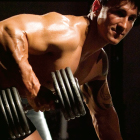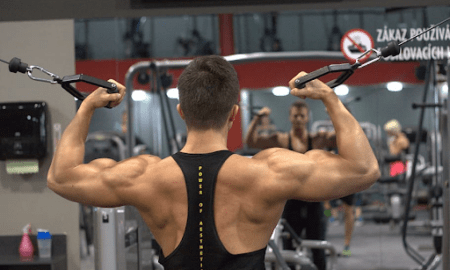 I have addressed dumbbell rows in previous columns over the years. This time I would like to examine a variety that is much different from the dumbbell rows commonly performed in the gym.
I have addressed dumbbell rows in previous columns over the years. This time I would like to examine a variety that is much different from the dumbbell rows commonly performed in the gym.
Dumbbell rows are typically performed with one knee on a bench and the other foot placed on the ground. The back is flat and still, with one hand placed on the bench to further steady the body. The dumbbell hangs down and then is pulled to the chest with a minimum of body movement.
The idea is that keeping the body still will help isolate the back muscles. There is some validity to that, and I have discussed it. On two occasions, however, I saw athletes performing dumbbell rows a little more aggressively, and that enabled them to handle much more weight. The first time was college football players training under Hall of Fame strength and conditioning coach, E. J. “Doc” Kreis, who was at UCLA from 2003 to 2008. Each platform and power rack set (there were 55 platforms) had a set of adjustable dumbbells with a fixed amount of weight, but the athletes could add more. The athletes had performed so many power cleans, clean pulls, power snatches, glute/ham raises, squats and front squats on Monday, Tuesday and Thursday, that Doc Kreis allowed them to pull differently on Friday to avoid low-back fatigue, but he still wanted them to pull hard.
The dumbbells began at 110 pounds and would have weight added up to 200. The form was much looser than what you see in most gyms. The goal was to incorporate as many muscles as possible and to not have isolation. It was to generate and develop power. The pull was hard and fast, and the upper torso did twist a little as the dumbbell row neared the top of the pull. All-American Justin Hickman (now with the Indianopolis Colts), pulled 160 pounds for five sets of 10 reps. Another all-American, Maurice Drew-Jones (now with Jacksonville Jaguars), pulled 200 pounds for five sets of five.
The second time I encountered this was with Olympic rowers. One can clearly see the need for low-back and midback strength in elite rowers. The rowers used very heavy dumbbells similarly to the way the football players had used them. The rowers stabilized themselves as well as they could and pulled the dumbbell quickly and high with the torso twisting slightly also.
Neither group would benefit from the traditional form of row—with the exception of rehabilitative purposes. Nor would the average trainee benefit from the dumbbell rows that these athletes were performing.
My purpose with this column is to help trainees, trainers, coaches and athletes realize that there may be different ways to perform common exercises that can serve different purposes.
Doc Kreis is now helping professional athletes and developing youth athletes at the Soft Tissue Center in Marina del Rey, California.
Train smart. It will help you remain in the gym making more gains.
Editor’s note: Visit www.SoftTissueCenter.com for reprints of Horrigan’s past Sportsmedicine columns that have appeared in IRON MAN. You can order the books, Strength, Conditioning and Injury Prevention for Hockey by Joseph Horrigan, D.C., and E.J. “Doc” Kreis, D.A., and the 7-Minute Rotator Cuff Solution by Horrigan and Jerry Robinson from Home Gym Warehouse, (800) 447-0008 or at www.Home-Gym.com.




















You must be logged in to post a comment Login